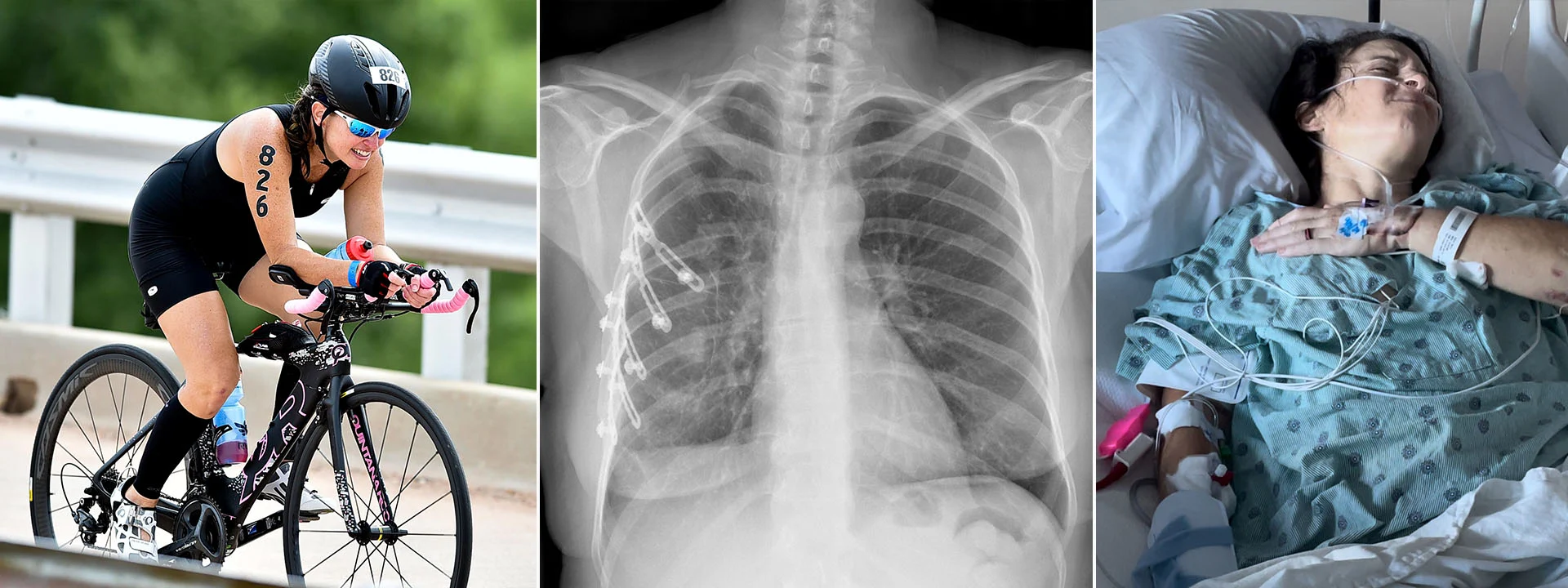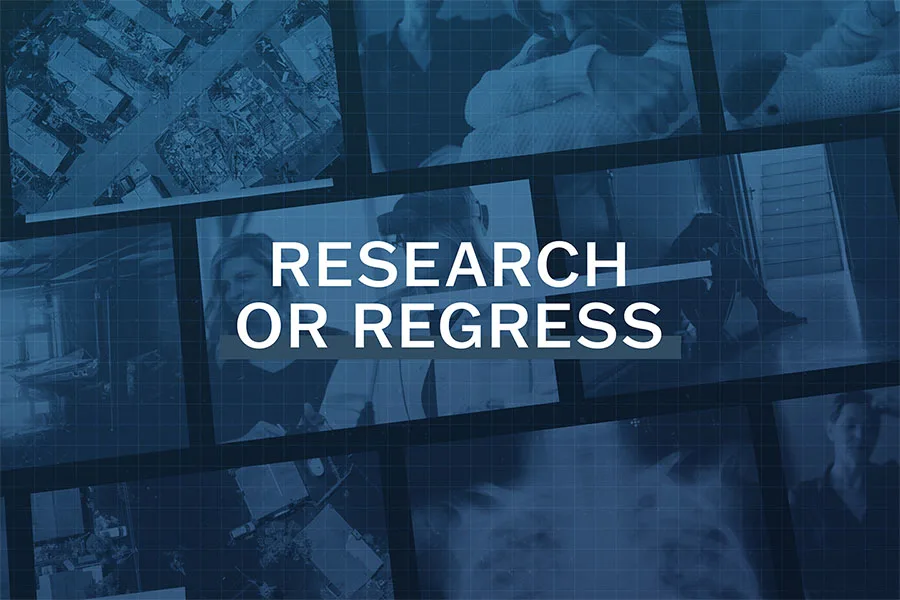
Research or Regress
What if there was a better way to heal broken ribs?
Broken ribs mean agonizing pain with every breath. A Penn State-developed system is helping patients breathe easier and heal faster.
Nancy Rehm, an accomplished multi-sport endurance athlete, was one mile from finishing a 51-mile bike tour in Waco, Texas, when she was involved in a near-fatal collision with an SUV. Thrown twenty feet and knocked unconscious, her life changed in an instant.
She arrived at a trauma center in critical condition. She suffered a concussion, a broken shoulder, and the right side of her chest was shattered. Her lungs struggled to inflate due to her injuries, allowing blood and air to collect in her chest cavity, putting her life in immediate danger.
"It was a very scary situation not knowing what was going to happen," Rehm recalled. She wondered if she would she ever breathe normally again? Could she return to the active life she loved?
To give Rehm the best chance at recovery, her trauma surgeon turned to RibFix Advantage—a groundbreaking medical advancement for repairing broken ribs developed at Penn State.

What researchers and doctors like Drs. Haluck, Mackay, and Dillon do matters. It changes people's lives and the lives of the family and friends around them."
Nancy Rehm
The Challenge: Fixing Broken Ribs Isn't Easy
Ribs act as a protective cage for vital organs like the heart and lungs. When a rib breaks, every breath is agonizing. Each year, hundreds of thousands of people experience broken ribs. The intense pain makes it hard to breathe and leaves them prone to infections or even a collapsed lung.
“A single rib fracture can cause tremendous disability. They’re painful and bring high risk for pneumonia, which can be life-threatening, especially for older adults,” said Randy Haluck, professor of surgery and vice chair of technology at the Penn State College of Medicine, who was part of the team that developed RibFix Advantage.
Traditionally, repairing broken ribs is a challenging and invasive process. It involves a lengthy operation where surgeons must expose the ribs, often from the armpit to the waist, to attach a metal plate to the outer surface of the fractured bone. The procedure is so hard on patients that it’s only used when there are multiple fractures.
Rehm’s case was extreme. She had nine broken ribs, seven of which were fractured in multiple places. This severely limited her ability to breathe.
"The immediate aftermath marked some of my darkest days both mentally and physically. I didn't know how to move forward," she shared. Doctors warned that traditional surgery would likely mean dealing with chronic pain for the rest of her life, making everyday activities difficult—let alone competing in triathlons.
A Better, Faster Way to Heal
Long before Rehm’s accident, physicians at the Penn State College of Medicine and the Penn State Health Milton S. Hershey Medical Center recognized the need for a better, more effective method to repair broken ribs.
Dr. Haluck, along with Dr. Donald Mackay, professor of surgery, neurosurgery, and orthopedics and rehabilitation, and Dr. Peter Dillon, former chief of surgery and current executive vice president and chief clinical officer at Penn State Health, had an idea. What if they could attach a metal plate to the inner surface of the broken rib, instead of the outer surface?
“The ribs are like a stone bridge. They do their job as long as the arch is intact, but as soon as you break the arch, it doesn’t function anymore,” Haluck said. By positioning the plate on the underside of the rib, it’s like pushing the stone back up and into the arch, restoring the arch’s structure.
Their groundbreaking invention became RibFix Advantage—the first rib fixation system cleared by the Food and Drug Administration (FDA) and used to help patients recover from broken ribs.
X-ray images show the innovative RibFix Advantage system in place, which helped repair Nancy Rehm's shattered ribs and accelerate her recovery.
Nancy Rehm's active lifestyle is a family affair, seen here sharing a moment with her daughter during an open-water swim in Canada.
Nancy Rehm's passion for triathlons shines through as she races in an Ironman event in Lubbock, Texas.
After a long and difficult recovery, Nancy Rehm is back doing what she loves, cycling with her husband.
Less than ten months after her accident, Nancy Rehm proudly competed at the World Triathlon Multisport World Championships in Spain.
A New Standard in Trauma Care
RibFix is a true medical breakthrough and is changing how doctors treat potentially life-threatening chest injuries. This less invasive method translates to fewer complications, reduced risks, and shorter hospital stays, giving patients a better path to recovery. In many cases, the procedure takes less than an hour and requires only three small incisions along the chest.
While healing from both the surgery and the accident's trauma was challenging, Rehm's progress has been remarkable.
“Every medical professional I’ve encountered along the way is beyond shocked at the pace of my recovery,” she said. “They say that they wouldn’t normally see this kind of improvement at all, let alone within five or six months.”
Less than ten months after surgery, Rehm was in Spain for the World Triathlon Multisport World Championships, a race she qualified for before her accident. She participated in the Parade of Nations with her husband and daughter, and all three competed in the race. Rehm recounted that crossing the finish line of the race felt like a dream.
And there’s still the promise and potential for even more progress.
“What researchers and doctors like Drs. Haluck, Mackay, and Dillon do matters. It changes people's lives and the lives of the family and friends around them,” Rehm said. “RibFix gave me a chance to improve my situation and that’s huge. I’m so grateful that the doctors at Penn State thought that there had to be a better way.”
This is Penn State Research

What happens if it stops?
Learn more about the implications of federal funding cuts to your future.





